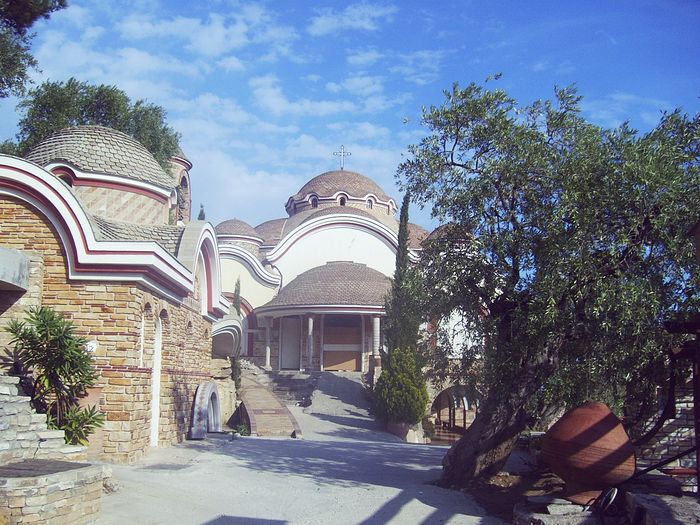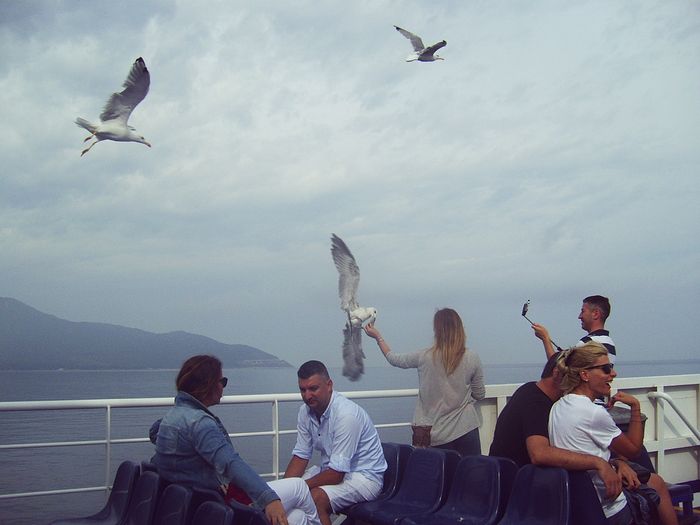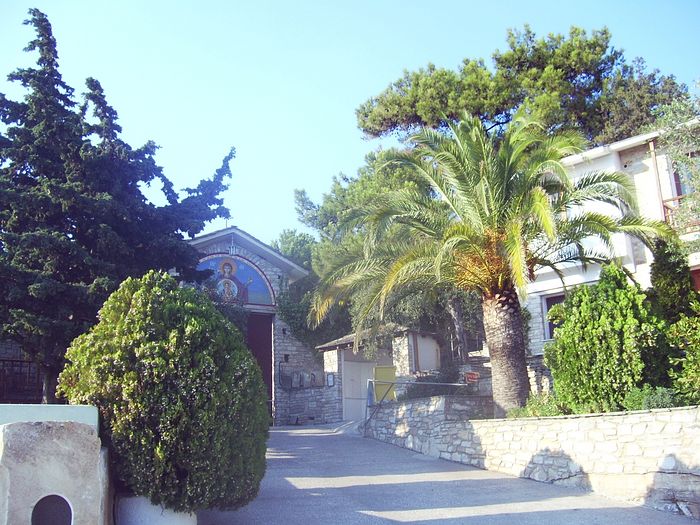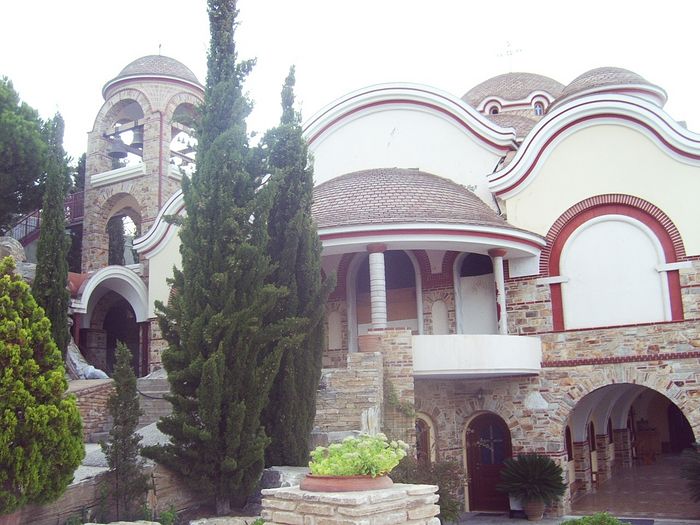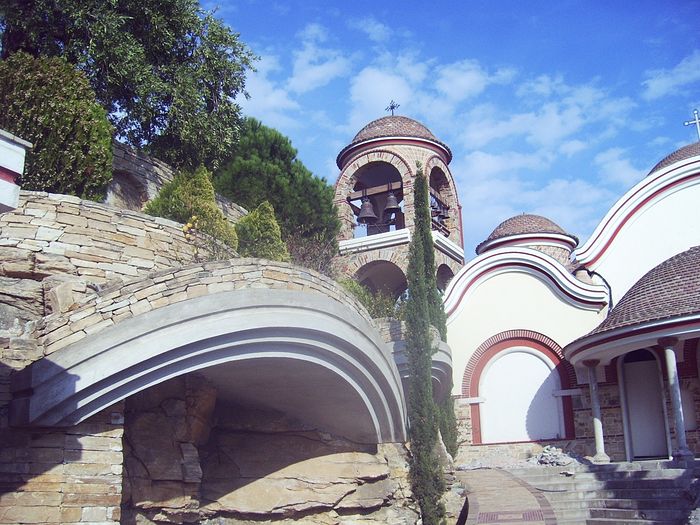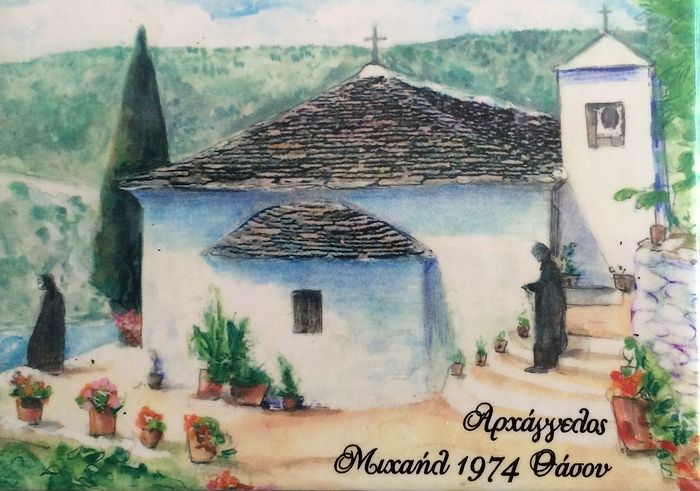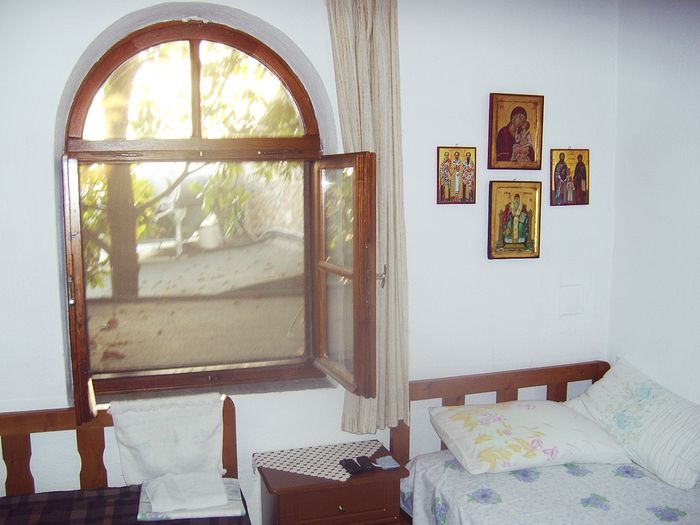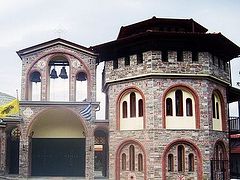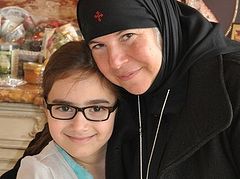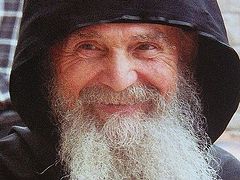Previous article: A Desert Paradise: How Holy Ascension Monastery in Proti Serron, One of the Monasteries of Elder Ephraim of Arizona, Was Restored
Today I’m leaving the wonderful mountain Monastery of the Holy Ascension near the village of Proti in the Serron district, restored with the blessing and prayerful help of Elder Ephraim of Philotheou (Arizona).
My journey continues to the island of Thasos, to the Monastery of the Archangel Michael, a dependency of the Athonite monastery of Philotheou. This monastery was also reborn with the help of Elder Ephraim of Philotheou. The spiritual children of Mother Anisia, the abbess of Holy Ascension Monastery, the spouses Elena and Yannis give me a ride to the port of Keramoti. The two-story ferry is ready to sail, with cars on the first floor and passengers on the second. There are seagulls traveling along with the ferry. They land on your hands and beg for food. I get to know my neighbors—a British family that has already been to Thasos before.
Russians don’t come to this island often, although Bulgarians and Romanians and Germans and the English love to vacation here. Turks also love to vacation on Thasos, as a fellow traveler from Turkey explained to me later: It’s cheaper to go on vacation here than in his homeland.
The ferry docks quite quickly and completely silently. The capital of Thasos is the port of Limenas (which means “port” in Greek). The English family remains in Limenas, but my path lies fifteen miles to the south, on the southeastern tip of Thasos, from where you can see the coast of Holy Mount Athos in good weather.
A huge number of churches on a tiny island
I wait for the bus for about an hour. It goes all the way around Thasos. The island has an ancient history—it is already mentioned sixth-century BC chronicles. For many centuries, the island was controlled by Thracians and Phoenicians, Athenians and Spartans, Persians and Romans, Byzantines and Turks.
There is a huge number of churches on this little island. The locals are faithful and pious people. Every village certainly has a church, and in some cases, there are tiny villages with a population of a few hundred people that even have several churches.
There are many ancient icons from the fourteenth to sixteenth centuries. There’s the wonderful Church of the Dormition of the Most Holy Theotokos in the village of Panagia, and the oldest church on the island—of St. Athanasius. The Church of St. Paraskeva, in the ancient mountain village of Theologos, has an icon of the Theotokos painted, according to Tradition, by the Evangelist Luke. There is the most beautiful mountain monastery of the holy Great Martyr and Healer Panteleimon, where only one nun labors, however. The island is dedicated to the Archangel Michael and lives under his powerful protection—under the shadow of his mighty wings.
A beautiful creation of God
It gradually becomes clear what draws people to Thasos: The entire island is a beautiful creation of God, and its nature sings the praises of the Creator! The beauty of the “emerald” island is striking, covered with green forests (pines, cypresses, sycamores, oaks, lime trees, olive groves), the amazing clean beaches with blue flags that are an international award for clean water and safety. In Russia, by the way, only one beach has this flag—in the village of Yantarny in the Kaliningrad Province, on the coast of the Baltic Sea.
Not many people live on Thasos: only 14,000 people in an area of 155 square miles. Also, the island is entirely covered with marble—absolutely all of it! They even add marble chips to the roads, making them better—stronger and more reliable.
The sea is saltier than, say, the Black Sea, and when you swim in it, you remain on the surface. A gently sloping shore. Thanks to the clear, turquoise water, you can clearly see the bottom, as well as a lot of fish. Right next to a swimmer, a whole school of golden-blue fish rises and falls again. A long-necked bird dives into the water from time to time, searching for its lunch. A little off from the beach, on the rocks, is a large colony of sea urchins. It’s a good thing I noticed them before I decided to walk on the rocks. You can clearly see beautiful orange anemones in the water.
There are no industrial enterprises here. There is only one factory, making jewelry—“Golden Iris,” known all throughout Greece for its handmade products. Only twenty craftsmen work at the factory, and three of them have gained global fame for their skills. The beauty of their native nature obviously inspires them to create masterpieces.
Thasos beekeepers and fishermen
They grow olives on Thasos and do beekeeping and fishing. They catch mullet, horse mackerel, herring, and octopi here, which are even a pity to eat—these octopi are smart. They can be trained, they have good memories, and they are uncommonly intelligent: They clean up where they live and put the remains of food and garbage outside, in a garbage heap.
The local apiary owners and fishermen prudently do not use any pesticides, and this is one of the main reasons for the cleanliness of the island. The olives of Thasos are a separate song. Nowhere else in Greece are there such delicious olives of rare varieties, which don’t require any pre-soaking for salting.
The Monastery of Archangel Michael
And now I’m at the stop near the Monastery of Archangel Michael. It is located at an altitude of 820 feet above sea level and is built as a fortress on the steep rocky mountain slope, above a cliff. It creates the impression that the monastery is hanging over the sea. The Monastery of the Archangel Michael is mentioned in written sources from the end of the thirteenth century, although, according to tradition, it was founded by the ascetic Luke much earlier—around 1090. Ancient history…
Luke, a man of holy life, spent about fourteen years here in solitude and prayer and built a small church in honor of the holy Apostle John the Theologian. People started gathering around the ascetic, seeking spiritual guidance. Today the entire village of Theologos has grown up on that site.
Being a true zealot of reclusion and hesychasm, the ascetic Luke left human vanity and settled in caves where the Monastery of the Archangel Michael is now located. He labored there another twenty years in blessed asceticism and deep prayer.
My first acquaintance
The heavy gates of the monastery are closed at night and from 1:00 to 4:00 PM. They’re open now. I enter the monastery, and my first acquaintance awaits me.
Panagiotis lives in America. He and his wife make candles for the monastery. They receive spiritual direction from Elder Ephraim in Arizona [who reposed on December 8, 2019.—OC.], at the Monastery of St. Anthony the Great. In America, Panagiotis is called Peter—easier than pronouncing his Greek name. Panagiotis is very kind and hardworking. He has two daughters who are nuns in the monastery. One is fifty, the other fifty-one. Panagiotis comes to the monastery from America every year and labors here to the glory of God. His third child, a son, is married, and Panagiotis has five grandchildren. The gray-haired Greek smiles: “My son gives me grandchildren for himself and for his nun sisters.”
Later, I saw Panagiotis working every day: He was both a guard and doorkeeper, and he provided clothes appropriate for a monastery to numerous tourists who tried to come to the monastery in shorts, t-shirts, short skirts, and even in bathing suits.
“Panagiotis, good evening! Are you tired?”
“Good evening, Olga! I’m still alive… It’s difficult to dress women all day, especially Greeks…”
Panagiotis smiles. In the evening, he closes the heavy gates and hurries to the service. And there are many services here. The first is at four in the morning, the next at ten, and then two services in the evening.
The Archangel Michael saved his monastery
They were waiting for me in the monastery: A spiritual daughter of Elder Ephraim, Margarita from Thessaloniki, had told them of my arrival. Sister Irina accompanies me to a small cell under a tall olive tree. She speaks English well: “It’s wonderful that you came today, Olga! You wouldn’t have been able to get here yesterday. The roads were closed, and we had to be evacuated from the monastery under threat of fire.”
“Why was there such a big fire?”
“The weather was dry for a few weeks, and then there was a severe thunderstorm. Lightning struck the dry trees and huge fires started in several spots on the island at the same time.”
“Did your monastery suffer much?”
“The fire approached the walls of the monastery twice. The Archangel Michael defended us—the fire wasn’t able to come into the monastery. But our entire olive garden was burned down! All of our olive trees! Even the roots were burned—we won’t have our delicious olives anymore. But we are not discouraged—we know that it is because of our sins. We thank the Archangel Michael for saving his monastery!”
“Do you have such fires often here?”
“No, such strong ones are rare. That last big fire was twenty-five years ago. Nearly all the large animals that lived on the island—wolves, foxes—died. They suffocated. The small ones burrowed into the ground, hiding in holes, and the predators died. But we often have small fires: forests and summer heat…”
The huge olive garden was the monastery’s most valuable asset, and its loss is a huge loss for the sisters. The monastery has problems with water, and they ask us to conserve water and not use the shower.
Trapeza
They invite me to the trapeza. The sisters eat separately from the pilgrims, and with me at the table are Panagiotis, a German pilgrim, and an electrician working at the monastery. The food, like in Ascension Monastery, is the simplest: tomatoes, delicious dried olives, fried potatoes; on Sundays they add eggs, milk, and feta. They have traditional Greek coffee in the morning. There’s always a jug of cold water on the table. The monastery has a large garden, as well as goats and chickens, so the sisters feed upon the fruits of their own labors.
A great relic
The sisters stand apart at the services too, in the front of the church. After the services, everyone venerates the relics. The monastery’s main relic is a piece of one of the Precious Nails with which Christ was crucified. The holy particle of the Precious Nail, among several other relics, was given to Philotheou Monastery by Emperor Nikephoros III Botaneiates (1002-1081). This Byzantine emperor loved monasticism, patronized monasteries, and even restored Philotheou, which had fallen into decay.
This great relic is now kept in an icon of the Archangel Michael in a silver rhipidion (a liturgical fan with the image of a six-winged Seraphim, reminding the faithful that the holy angels are invisibly present in the church during the Divine Liturgy). The icon was made by a Fr. Anastasy from Bulgaria who was miraculously healed by the relic. Thus, the piece of the Precious Nail is protected by the Commander of the Heavenly Hosts, the protector of Thasos.
At the end of the service
At the end of the service, after bowing before the monastery’s icons and relics, everyone takes a blessing from the priest and Gerondissa Ephraima. In response to my bow, Gerondissa Ephraima bows even lower, such that we nearly bang foreheads. Mother is very humble. She is one of the most spiritually experienced of Elder Ephraim’s abbesses. It’s hard to distinguish her from the sisters; she often does not wear her abbess’ cross and can do any of the most everyday work, such as picking up a broom and calmly sweeping the yard, so it’s quite possible to take her for a novice.
Gerondissa Ephraima went to the monastery as a very young girl. She is from the city of Volos, where Elder Ephraim himself lived with his mother, Eldress Theophano, and Eldress Macrina, the abbess of the monastery in Portaria, a famous ascetic. Gerondissa Ephraima grew up, we can say, in the hands of Eldress Macrina and Elder Ephraim.
In 1973, Elder Ephraim was appointed abbot of Philotheou Monastery, and he promised the bishop of Kavala then that he would restore and open the monastery’s abandoned metochion on the island of Thasos. To restore the monastery, the Elder took several sisters from the monastery in Portaria, and also their spiritual daughters who aspired to the monastic life, in order to make them nuns later on.
How the monastery was restored
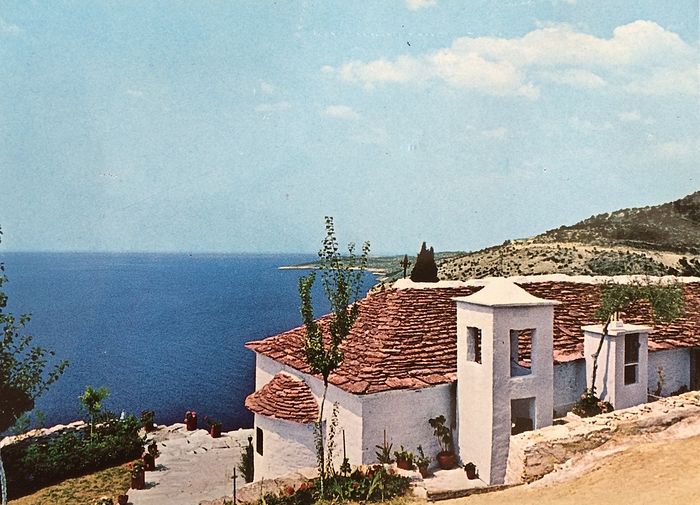 How the monastery looked in 1974
How the monastery looked in 1974
Elder Ephraim sent the first sisters to Thasos in September 1974 to examine the site where the ruins of an ancient men’s monastery were located. The sisters discovered that only one small church in the name of the Archangel Michael and a small house with one cell remained here, and even those were in disrepair. The house was being used by shepherds as a sheep pen. There were mice, dirt, and holes in the walls everywhere.
Nevertheless, the first sisters moved to the island in October 1974 and began work on cleaning up the territory and repairing the premises. The restoration work was so hard and life on the island so difficult that not all the sisters whom the Elder asked to help in the work were able to physically bear this podvig. Some had to be moved to other monasteries, and the Elder kept sending new novices to the island.
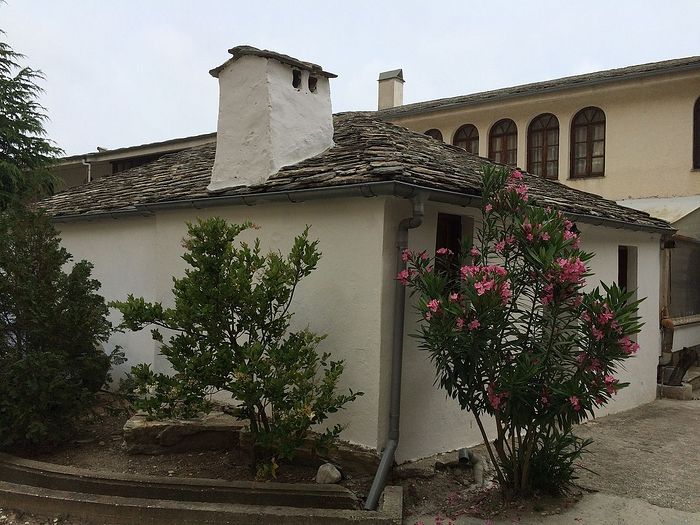 There were only two buildings in 1974: the Church of the Archangel Michael and this house (cell)
There were only two buildings in 1974: the Church of the Archangel Michael and this house (cell)
The monastery was restored over a period of ten years. When possible, Elder Ephraim would come by boat from Athos to serve in the monastery church. He fulfilled his promise to the bishop to restore the monastery, as well as many other monasteries in Greece.
The monastery’s priest
The monastery had no permanent priest at first: He would come only three times a year, on Nativity, Pascha, and if possible, at Annunciation. The priest who serves here now—Fr. Simeon—is a spiritual child of Elder Ephraim. Fr. Simeon is already on in years, all gray, attentive eyes, astute. His home is upstairs, above the pilgrim cells, a little off from the sisters’ territory of the monastery.
Early in the morning, when it’s barely light, I leave my cell to admire the dawn. The morning sea and the monastery churches are illuminated by the first rays of the sun. The heavy monastery gates are bolted shut. Silence. The sisters are resting after the night service. I can feel someone’s eyes on me and turn around. No one. But I clearly feel that someone is watching me. I lift my head up and see Fr. Simeon standing by his small cell, watching me intently. I put my hand to my chest and bow to the priest. He blesses me and goes into his cell. The shepherd watches…
Services in the monastery
Since there is a permanent priest in the monastery now, they serve the Divine Liturgy regularly: every other day during the week and on the weekends—that is, five days a week. If there is a feast during the week, then Liturgy is served even more often, even every day. The other days, they serve a moleben to the Archangel Michael or the Mother of God or another saint. After the night service, the sisters go to their obediences and work until one in the afternoon. Then begins quiet hour—time for rest or cell prayer. Then comes the evening service, dinner, and again obediences, and before sleep, Small Compline with an akathist to the Mother of God is served in the small Church of the Archangel Michael. Night services are held in the monastery every day—both the sisters’ days and nights are filled with prayer and work.
At first, there was neither water, nor light, nor a telephone in the monastery. Even now they don’t have the air conditioners and internet that we’re all used to.
The miraculous spring of the Archangel Michael
For drinking water, the first sisters of the monastery had to go down to the sea, to the spring of the Archangel Michael.
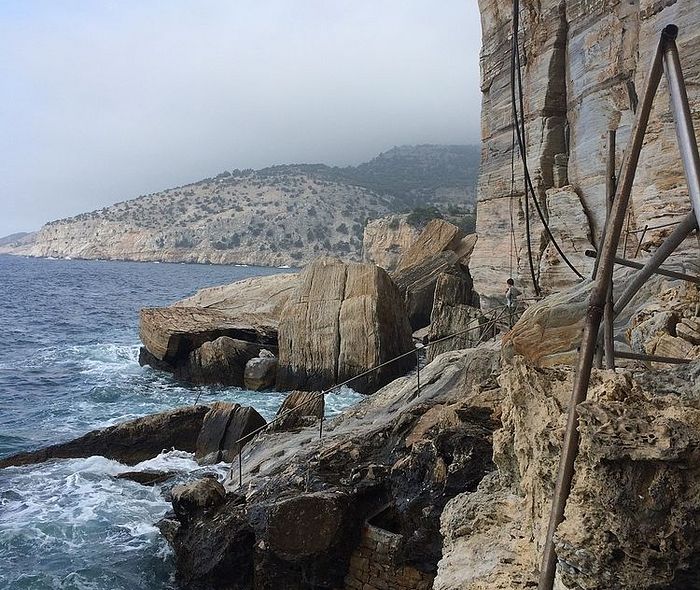 On the way to the hard-to-reach spring of the Archangel
On the way to the hard-to-reach spring of the Archangel
This is how the spring was formed, according to tradition:
The ascetic Luke, who labored here, was accounted worthy of a visit from the Archangel Michael. The Archangel blessed his labors, promised his protection, and after striking his staff on the rock, a spring of healing water poured forth. He said: “Drink from this fountain and build a church in my honor on this site, where people will receive spiritual benefits and be cured of diseases forever!”
Greatly desiring to serve the Lord, the Elder built a small church in honor of the Archangel Michael, with the holy water spring inside it. The fame of these miracles spread not just on the island, but also in the surrounding and in distant places, from where they started to bring those suffering from various diseases.
Years later, when the Ottoman invaders tried to desecrate the holy spring, it moved underground, and then moved closer to the sea, into a cave. According to tradition, the Archangel Michael himself appeared to Fr. Demetrios who came to serve in the Church of the Archangel Michael and found the dried-up spring. The Commander of the Heavenly Hosts blessed the priest to go down to the sea and find the spring in one of the caves where the light would be visible.
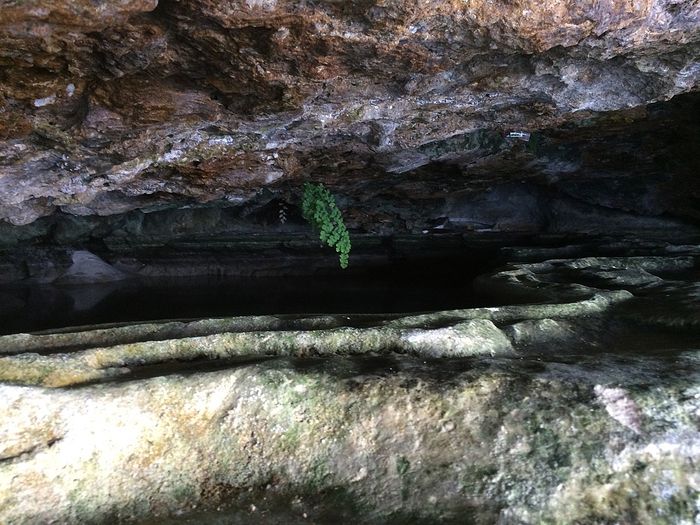 The spring itself is in a narrow cave
The spring itself is in a narrow cave
The pious priest went down to the sea with those who were thirsting for healing, and in one of the small caves they saw a wondrous light. As they drew closer, the bright light faded and a subtle fragrance spread through the air. The suffering people entered the cave on their knees and received healing from the wonderworking spring.
The path to the spring takes about two hours now; the road there is very difficult—“you have to jump along the rocks,” as Panagiotis told me. The spring is in a narrow cave. It is called “prostrating” because you have to literally crawl in the cave, as if prostrating to the Archangel Michael.
Many pilgrims are not even blessed to go down to the spring in view of their advanced age or weak physical state. Those who don’t feel able to go down to the miraculous spring can take a small bottle with holy water from the monastery shop.
The miraculous help of the Archangel Michael
The Archangel appears to many residents of the island, in full stature, in military armor, and fulfills their secret requests, cures their incurable diseases, and instructs them to return to the path of repentance and salvation.
The monastery has a museum where it keeps all the offerings to the Archangel Michael, donated by those who are grateful to him for having received miraculous healing and other help. The museum has many of the most beautiful sabers and swords that people bring as a gift to the Commander of the Heavenly Hosts.
It is noteworthy that when young men are sent to serve in the army, first a moleben is served before the relic in the monastery, and only then do they go to the service, having been blessed.
The sisters have gathered numerous testimonies of the appearances of the Archangel Michael and his miraculous help. Here are a few of them:
I opened my monastery
The wife of the priest from the village of Kallirachi tells the following story. Her brother, a pious man, sent a gift to the Monastery of the Holy Great Martyr and Healer Panteleimon on the island of Thasos in 1972—a large tray, twelve forks, and as many spoons. In 1973, he and his brother came to the ruins of the Monastery of the Archangel Michael. His brother looked around and said: “What a good monastery this would be if there were some inhabitants!” Then the brother of this presbytera went to Germany and heard nothing about the monasteries on Thasos.
In October 1974, he had the same dream three nights in a row: A young man appeared to him, dressed as a warrior, with a sword in his hand, in metal armor with shoulder and thigh pads, in a scarlet cloak—as the Archangel Michael is depicted in the icon. The youth said: “My name is Michael.”
Her brother was afraid of the gleaming sword, but the youth calmed him and declared: “I opened my monastery. And I want you to send me the same thing you sent St. Panteleimon.”
Her brother urgently wrote a letter to Thasos, describing his dream to Presbytera and asking her to find out whether the monastery had really opened. He also sent a package with the same gift as to the Monastery of St. Panteleimon. Presbytera immediately wrote back that the first inhabitants had just recently come to the monastery, in October 1974, and were truly in great need. And her brother, struck by the appearance of the Commander of the Heavenly Hosts, wept.
I felt the wind blowing behind me
Niki Kalozi from Pataglia, from the island of Thasos, told about how she came to the monastery on the day of the commemoration of the Archangel Michael and brought her daughter with her who was sick with a high temperature. She carried her daughter in her arms into the church because she couldn’t even stand on her feet. During the All-Night Vigil, despite the closed doors and windows, Niki felt a noise behind her, a blowing, like the whoosh of the wind among the sycamores.
A familiar old woman, Polixeni Petridou, was standing next to her, and to Niki’s bewilderment she said: “The great grace of the Archangel Michael! After all, it’s the Archangel to whom you were praying now and asking to heal your child!”
When the Liturgy ended, the sick girl got up herself, without a fever, feeling healthy. She ate well and was fully healed.
We tried a wet match, and it lit
Evangelia Tzanopoulou from Aiani Kozani testifies to the miraculous help of the Archangel Michael in resolving her barrenness. She and her husband were married for thirteen years but had no children. The doctors they went to for help ruled out any possibility of Evangelia having a child for medical reasons. When she and her husband happened to read about the monastery in 2000, they decided to go.
They venerated the monastery’s icons and relics and fervently prayed and confessed. Then they went to the spring, despite the inclement weather. When they entered the cave on their knees, they wanted to light the lampada that was there, but they didn’t have a lighter, and the matches they found in the cave were so wet from the dampness and water that it was impossible to light them.
However, by some inspiration, the couple tried one of the wet matches, and it immediately lit. They were able to light the lampada, and it was the first miracle for them and a sign of the Archangel Michael’s favor towards them. The second miracle was that Evangelia, who had been suffering from severe pain in her neck for a long time, realized after returning from the spring that her neck didn’t hurt anymore. The pain hasn’t returned for five years now since the pilgrimage to the monastery. And the third miracle—they have a healthy, boy, four years old!
The sea subsided in a second
George from Thessaloniki recalls how in 1999 he and his fiancée were on vacation on the island of Thasos. Driving across the island, they stopped at the Monastery of the Archangel Michael, looked around, lit some candles, and then continued driving. They decided to go swimming in the bay near the monastery. There were only a few foreigners relaxing on the beach. The sea was very calm, but when George and his fiancée swam away from the shore, strong waves suddenly rose up and started carrying them farther and farther from shore.
George was a good swimmer and tried all styles of swimming, but he and his fiancée were being carried farther and farther out to sea, and no matter how they tried, they couldn’t move a single foot closer to shore. At some point, the girl said to George: “I can’t swim anymore!” The people on the shore were like dots on the beach, and the young man fell into despair, that he wouldn’t be able to save his fiancée and that they might both die.
Suddenly, by some impulse, George turned his head towards the monastery and shouted: “Archangel Michael, help us!”
And help came immediately! The sea subsided in a second, and the young man and woman were able to swim to the safety of the shore completely calmly. They got out onto the sand, completely exhausted, hugged one another, and having caught their breath, immediately went back to the monastery to thank the Commander of the Heavenly Hosts for the miraculous rescue.
This incident was a turning point in George’s life. From then on, he and his fiancée, who soon became his wife, turned to God and started going to confession and entered the life of the Church.
Having returned home from Thasos, George opened a book of St. Paisios the Athonite, and the first thing that caught his eye was some lines about gratitude to God. George decided to name his future son Michael. And indeed, he and his wife now have a daughter and a son, Michael.
I don’t need a blood transfusion anymore
Yannis Theodoropoulos from the city of Volos tells about how he was born with a serious blood disease. From a young age, he had to undergo a blood transfusion nearly every month, and he suffered greatly. In 1996, twelve-year-old Yannis and his parents came to the monastery, where he fervently prayed to the Archangel Michael. One of the sisters blessed him with a reliquary.
When he returned home, Yannis felt that his health had greatly improved. To his surprise, and to the surprise of his parents, instead of decreasing like before, his hemoglobin count started to increase to the necessary amount, and then stabilized. Since 1996, Yannis hasn’t needed any more blood transfusions.
According to the Athonite typikon
As the monastery was a metochion of the Athonite Monastery of Philotheou for centuries, so now it is not independent but is subordinate to the Athonite monastery and lives according to the Athonite typikon. The sisters labor with the main goal of spiritual perfection and at the same time keeping the Precious Nail and serving the pilgrims who visit.
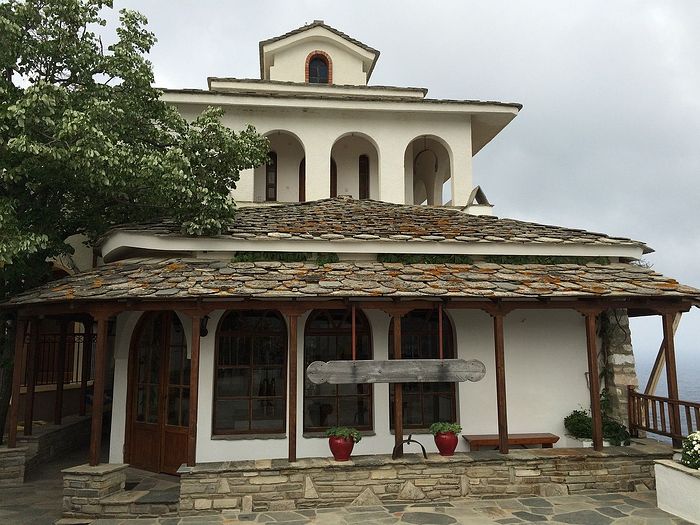 The museum of the Archangel Michael
The museum of the Archangel Michael
Over the years, the sisters completed the wings of the brothers’ buildings, the pilgrim’s hotels, and the modern workshops for the sisters’ obediences. The Cathedral of St. Silouan the Athonite was built to accommodate all pilgrims during the services. With the blessing of Elder Ephraim, the construction of another church, of the Holy Wisdom of God (Agia Sophia), has begun. By the way, the bells for the new church were brought from Russia. This church hasn’t been finished yet due to a lack of funds.
Elder Ephraim brought his mother to this monastery
It was to this monastery that the Elder brought his mother, Eldress Theophano, in 1983. The Eldress was ninety-two then. She spent the last three years of her life here and departed to the Lord on February 27, 1986. A reliquary was made in which her precious head was placed and is kept in the monastery to this day. Our next article will be about Eldress Theophano.
Holy Archangel Michael, pray to God for us!
Next article: A Novice of Her Own Son: On Gerondissa Theophano, the Mother of Archimandrite Ephraim of Philotheou

